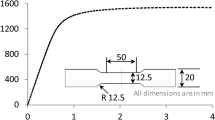Abstract
The problem of studying a scratch from a single abrasive grain is formulated, which involves finite element modeling of the interaction of the abrasive grain with the workpiece and an experimental study of obtaining and processing the grain traces on the real surface of the samples. A comprehensive investigation technique is proposed, including modeling the process of a single microcutting with an abrasive grain in the software system for analysis by the ANSYS Workbench finite element modeling method and an experimental study of the surface after microcutting with a grain. The applied research technique showed that, in general, the microreliefs of the traces created by a single abrasive grain, obtained during modeling and in the experiment, have a similar nature. At the same time, the numerical values of the geometric parameters have a scatter explained by a number of factors.




Similar content being viewed by others
REFERENCES
Shipulin, L.V. and Frolov, A.A., Study of microrelief of trace after cutting with a single abrasive grain, Progressivnye tekhnologii v mashinostroenii. Tematicheskii sbornik nauchnykh trudov (Progressive Technologies in Machinery Manufacture: Thematic Collection of Sci. Papers), Mazein, P.G., Ed., Chelyabinsk: Yuzhno-Ural. Gos. Univ., 2021, pp. 25–32.
Voronov, S.A., Kiselev, I.A., Ma, V., and Shirshov, A.A., Imitation dynamic model of grinding process for complex-shaped elements: Development of modeling methods, Nauka Obraz.: Nauchn. Izdanie Mosk. Gos. Tekh. Univ. Baumana, 2015, no. 5, pp. 40–58. https://doi.org/10.7463/0515.0766577
Sira, N.M., Kologoida, A.V., Litvin, O.O., and Kal’chenko, D.V., Definition of force cutting at fair grinding of cylindrical and needle roller surface of a textile machine, Tekhnichni Nauki Tekhnologiï, 2019, no. 1, pp. 63–72. https://doi.org/10.25140/2411-5363-2019-1(15)-63-72
Kal’chenko, V.I., Kal’chenko, V.V., Kuzhel’nii, Ya., and Morochko, V., Determination of cutting forces during finishing grinding of the cylindrical surface of the shaft, Tekhnichni Nauki Tekhnologiï, 2019, no. 1, pp. 41–52. https://doi.org/10.25140/2411-5363-2019-1(15)-41-52
Öpöz, T. and Chen, X., Experimental and numerical study on scratching test, Mater. Sci., 2013, vol. 22, no. 5, p. 34.
Chen, X. and Öpöz, T., Simulation of grinding surface creation–A single grit approach, Adv. Mater. Res., 2010, vols. 126–128, pp. 23–28. 10.4028/www.scientific.net/AMR.126-128.23
Rypina, L., Lipiński, D., Bałasz, B., Kacalak, W., and Szatkiewicz, T., Analysis and modeling of the micro-cutting process of Ti-6Al-4V titanium alloy with single abrasive grain, Materials, 2020, vol. 13, no. 24, p. 5835. https://doi.org/10.3390/ma13245835
Ardashev, D.V. and Shipulin, L.V., Simulation of grinding with wear of the abrasive grains, Russ. Eng. Res., 2017, vol. 37, no. 2, pp. 150–153. https://doi.org/10.3103/S1068798X17020034
Shipulin, L.V. and D’yakonov, A.A., Imitation model of forecasting surface relief when forming it during cylindrical grinding, Procedia Eng., 2016, vol. 150, pp. 936–941. https://doi.org/10.1016/j.proeng.2016.07.066
Woldman, M., van der Heide, E., Tinga, T., and Masen, M.A., A finite element approach to modeling abrasive wear modes, Tribol. Trans., 2016, vol. 60, no. 4, pp. 711–718. https://doi.org/10.1080/10402004.2016.1206647
Ma, V., Development of methodology of choosing the rational parameters of grinding process on the basis of accounting for dynamic characteristics of deformed technological system, Cand. Sci. (Eng.) Dissertation, Moscow: Bauman Moscow State Tech. Univ., 2018.
D’yakonov, A. and Shipulin, L., Complex modeling of flat peripheral grinding process, Naukoemkie Tekhnol. Mashinostr., 2013, vol. 24, no. 6, pp. 14–18.
Darafon, A., Warkentin, A., and Bauer, R., 3D metal removal simulation to determine uncut chip thickness, contact length, and surface finish in grinding, Int. J. Adv. Manuf. Technol., 2013, vol. 66, no. 9, pp. 1715–1724. https://doi.org/10.1007/s00170-012-4452-1
Salisbury, E., Domala, K.V., Moon, K.S., Miller, M.H., and Sutherland, J.W., A three-dimensional model for the surface texture in surface grinding, Part 1: Surface generation model, J. Manuf. Sci. Eng., 2001, vol. 123, no. 4, pp. 576–581. https://doi.org/10.1115/1.1391427
Funding
The work was supported by the Russian Science Foundation, agreement no. 22-21-20088 of February 21, 2022, topic “Development of a Methodology for Designing High-Speed Processing Operations Based on the Use of a Digital Twin of the Process.”
Author information
Authors and Affiliations
Corresponding author
Ethics declarations
The authors declare that they have no conflicts of interest.
Additional information
Translated by G. Dedkov
Publisher’s Note.
Pleiades Publishing remains neutral with regard to jurisdictional claims in published maps and institutional affiliations.
About this article
Cite this article
Shipulin, L.V., Frolov, A.A. & Shulezhko, E.I. Experimental and Finite Element Investigation of a Scratch on the Surface of a Workpiece from a Single Abrasive Grain. J. Mach. Manuf. Reliab. 52, 828–833 (2023). https://doi.org/10.1134/S105261882307021X
Received:
Revised:
Accepted:
Published:
Issue Date:
DOI: https://doi.org/10.1134/S105261882307021X



